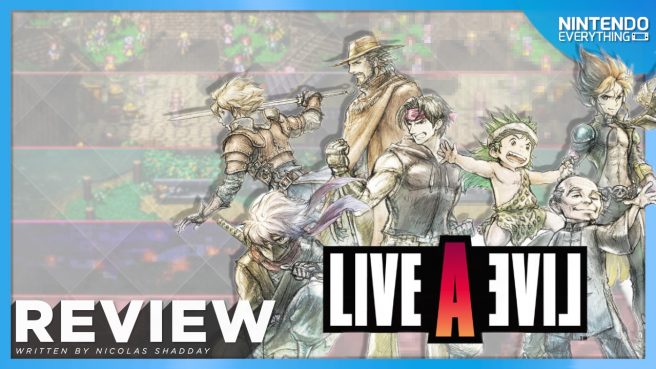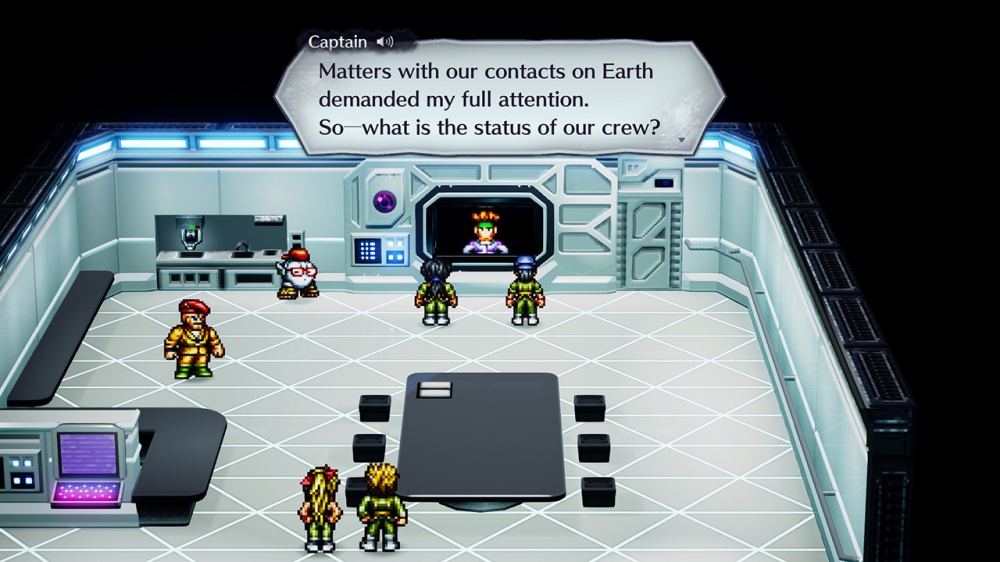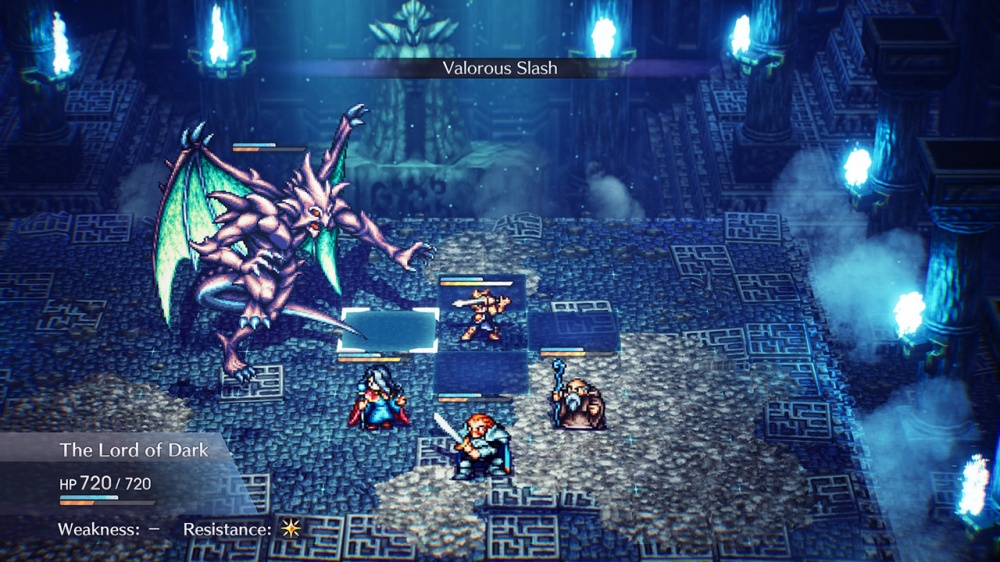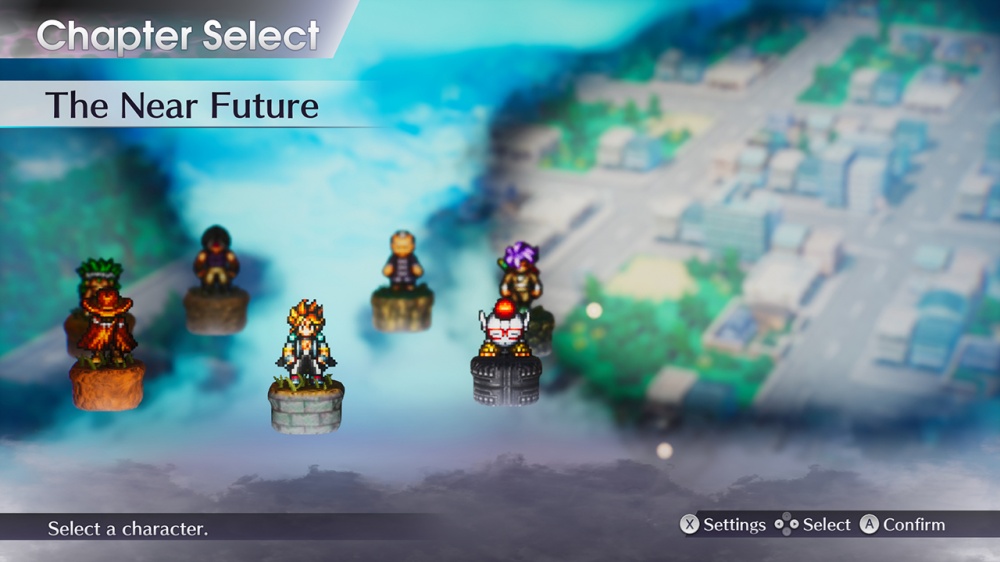System: Switch
Release Date: July 22, 2022
Developer: Square Enix / Historia
Publisher: Square Enix
Back in the days of the SNES, it wasn’t uncommon for games to never see a western release, remaining land-locked to their native Japan. This was relatively common in the case of JRPGs, an arguably oversaturated genre at the time that remained relatively niche in the west. Even new installments of big flagship franchises like Square Enix’s (then Squaresoft) Final Fantasy series didn’t always make it overseas. It’s no surprise then that some of Square’s less well-known JRPGs ended up falling through the cracks, one of these being Live A Live. Live A Live was originally released in 1994 and had even been initially planned as a worldwide release before underwhelming sales prospects in Japan caused those localization plans to be scrapped. But with the game now receiving an unexpected remake, it’s gotten a new lease on life and a long overdue international release, letting everyone experience this presumed classic. That being said, how well does the game truly hold up today? And were the improvements made to this remake enough to bring it up to a more modern standard?
Live A Live is frankly a very unique experience, even in the realm of older JRPGs. Rather than following a single narrative throughout the game, the experience is broken up into seven main story scenarios, along with a couple of unlockable story-heavy chapters, one providing a different scenario, main character and setting, while the other ties all of the game’s narratives together. My gut reaction was that this felt very similar to Octopath Traveler, another recently-released Square Enix RPG that used the HD-2D art style and features a story split across eight separate characters, with all of the stories ending up loosely tied together. However, I very quickly learned that this was an inaccurate analogy, as Live A Live handles its various story scenarios very differently from Octopath Traveler. See, Live A Live’s chapters all take place across different eras, with completely different casts of characters showing up in each one. But what might not be obvious at first glance is just how differently each scenario plays out, not only from a story perspective but from a gameplay one as well.
Every scenario shares a general framework of battle mechanics, menus, etc, but the specific gameplay of each one of them can vary wildly. While one scenario might be a fairly standard medieval fantasy RPG setting complete with random battles and silent protagonist, another might be purely story-focused, only featuring a single battle and leaning on its story and atmosphere instead. While you might be playing one scenario that consists of a straightforward Street Fighter-esque Boss Rush, the next might feature a Metroidvania-like setting with plentiful secrets, a stealth mechanic and multiple endings. The diversity that each and every scenario offers is staggering and completely caught me off-guard in the best of ways. Between the variety offered, the fact that every scenario is relatively short (most clocking in at 30 minutes to three hours) and that you can freely swap between scenarios at any time, you’re unlikely to get bored as there’s always something new to experience and nothing ever feels like it drags on for too long, a genuine concern you might have when playing an RPG.
The one caveat is that not all stories are created equal; because of how different they all are, you might find yourself resonating with one particular scenario, but be relatively unimpressed with another. For instance, while I truly enjoyed certain chapters like the Twilight of Edo Japan or the Distant Future, others like the Present Day or Prehistory were substantially less interesting to me. I wouldn’t say they were actively bad or significantly hampered my experience at least, but they certainly felt like rough patches I needed to work through if I wanted to get back to the fun portions of the game. Thankfully, since most scenarios in Live A Live are pretty short as I mentioned earlier, they didn’t drag on for too long.
Now, although story is an important aspect of most JRPGs, it’s a tad difficult to discuss it in the context of Live A Live. The issue lies in the same aspect I mentioned before, where the different themes of each scenario make their stories drastically differ in quality. This isn’t helped by how short they all are, making a few specific scenarios feel somewhat rushed, while others don’t even have much of a story to speak of. Now, that’s not to say all of the narratives presented are poorly designed; some of them are genuinely compelling, and the two unlockable chapters do a solid job of wrapping up each of the game’s plots thematically. I do wish that a few chapters in particular had the time to properly wrap up all of their loose ends, but at least the story doesn’t drag the game down in any real way. In the end, it just means that other than the sheer variety of narratives on display (which is a genuine strength of the game), Live A Live’s story is not the game’s main selling point.
What is one of the game’s strongest aspects, however, is its presentation. Live A Live uses the same HD-2D art style that Square Enix’s Team Asano has previously employed for Octopath Traveler and Triangle Strategy. And while I already found this art style incredibly appealing in those games, I cannot overstate just how incredibly well Live A Live utilizes this style. The sprite work is very detailed and charming as expected, but the way the game utilizes panning camera angles, lighting and visual effects is honestly breathtaking. Be it staring up at a Japanese castle as you run across its rooftops, or peering down a dimly-lit unsettling hallway, Live A Live’s gorgeous visuals do an incredible job at drawing you in and immersing you in that particular scenario’s setting, to such extent that I feel comfortable calling it one of the most visually appealing games on the system.
It’s no slouch from a musical standpoint either. Yoko Shimomura, famous for her work on Super Mario RPG, Kingdom Hearts, Xenoblade Chronicles, and a whole slew of other RPGs returns to compose the remake’s soundtrack, having handled the original game’s score as well. And as expected, she’s done an excellent job; there’s a lot of musical variety at play between all the different eras, from the twangy strings of the Wild West to the funkier vibes of the Near Future. All the music is head-bobbingly good while retaining the identity of each respective scenario, and battle themes maintain those era-specific vibes while injecting a healthy dose of action and excitement into the tracks. And that’s not even mentioning some of the more general-purpose songs, like the boss theme Megalomania or the game’s title theme, which feel absolutely iconic in their own right. Add to that a nifty Jukebox feature that lets you replay any of the game’s tracks, and I can safely say that the game’s music is a fantastic complement to the gorgeous visuals.
I also want to bring special attention to the game’s voice acting, as it’s present in most of the game’s cutscenes and I was genuinely impressed by how consistently good it was. Granted, there are certainly a couple of characters whose performances don’t hold up, but the vast majority of characters sound really solid and match their respective settings particularly well (special props to the excellent Wild West cowboy voices and Mariachi singing). I also appreciated that many of the Japanese and Chinese characters are voiced by actors of Asian descent; that’s not something you see very often, and not only does it help with industry representation, but it also adds an extra layer of authenticity and immersion to the voice acting.
From a gameplay standpoint, Live A Live seems pretty true to the 1994 original. Combat is the highlight, as it’s one of the more unique systems the game has. Every battle takes place on a 6×7 grid, sort of reminiscent of a traditional strategy RPG. Characters operate on an ATB-like system, with each of them possessing a “charge gauge” that, once filled, allows them to perform an action. This can simply be movement, which doesn’t consume your gauge, or a more significant maneuver like an attack or the use of an item. Charge gauges only fill in-between actions, so it’s worth noting that it isn’t truly real-time, and you’ll be able to ponder each move like in a regular turn-based system. To go along with the grid-based map, every attack or item you use has a specific range to it which can vary dramatically depending on the specific technique. There’s also a system at play where hitting enemies from the side or back makes you less likely to miss attacks or lets you deal extra damage. However, the size of enemy sprites and the ways that they are oriented make it pretty difficult to tell when you’re actually flanking foes, so I can’t say this was a system I was able to utilize very well.
Overall, I enjoyed the combat; each scenario provided characters with different niches, which meant your approach to battles was unique for every chapter and enemy encounters were more engaging as a result. You also learn new attacks at a rapid pace, which helps provide a solid sense of progression as you play. Admittedly, the system is a little obtuse at first, and definitely takes some fiddling to get used to it. But once you figure out how to properly utilize your movement and range, battles really do become quite fun and strategic, especially when you have a full party of four characters. And this is important, since some of the enemies and bosses you face can be a challenge, requiring a decent amount of strategy and forethought.
I did have some issues in the nitty-gritty aspects of combat though; personally, I like number-crunching in my RPGs so I can min-max and build specific strategies, and Live A Live fails to provide the information needed to do that. Aside from not including elements like numbered damage ratios, accuracy, and the like, there are some pretty glaring omissions when it comes to battle information. Some notable examples for me were the game never explaining the difference between Martial Techniques and Special Techniques or the Physical and Special Attack stats, or the fact that your individual attacks can scale off of completely different stats with very little consistency to try and interpret. I’d be lying if I said this was a dealbreaker, but it is frustrating to learn that certain attacks scale off of Speed or Defense instead of Physical or Special Attack when the game gives no direct indication of this, as it basically forces you into looking up information online if you want to understand the nuances of the system. This is especially disappointing, since the tutorial system for the game is otherwise very good. It provides loads of information very clearly and concisely, and lets you freely check it whenever you need a reminder. The game also features a vast array of buffs and debuffs you can apply in order to add further complexity to the battle system, and it provides the option of bringing up a chart mid-battle to detail all their effects, which is very much appreciated.
Outside of battle, the game operates like a fairly standard RPG, if a little dated in some of its mechanics. Menus stay consistent across scenarios, which helps provide a common framework for the game as a whole. The menu is fairly standard, letting you access settings or check your character’s stats and abilities as expected, but mostly you’ll be using it to manage your equipment. You’ll be doing this often, since every character possesses up to ten freely customizable equipment slots, providing tons of opportunity for you to optimize your stats however you please. The way you obtain equipment (and items in general) can vary greatly based on scenario, although most often you’ll be obtaining them from defeating enemies or poking around the overworld. Speaking of which, exploration is a pretty interesting component of the game, since again, it’s very dependent on the specific scenario. It’s almost always present in some form, although it can range from incredibly straightforward to surprisingly labyrinthine; in either case, the gorgeous visuals provide a solid motivator to exploring these environments, even when the layout of the environments themselves aren’t the most engaging.
Another big incentive to exploration is the significant number of secrets the game has tucked away. It feels a bit like a holdover of the classic era the game originally came from, as the game is positively dripping with Easter eggs, superbosses and hidden items. Your mileage may vary on how much you enjoy having this content hidden away, especially because some of it is truly obscure (think running away from battles a hundred times in one scenario or following a specific unmarked set of tiles in an inconspicuous room). For my part, I think it’s a neat little aspect of the game. It’s all very much optional content, and even if you don’t naturally stumble into it, there’s some fun to be had in looking up aspects of the game’s scenarios online after beating them and having those “Wait, you can fight that?” moments. And because each scenario is so short, it’s easy to do a second run-through of them if there are any secrets you might want to experience.
The Verdict

Ultimately, I have to recommend Live A Live, as I really did enjoy my time with it. It was certainly a product of its time, and even after being remade, it still shows its age through some of its mechanics and general design. But the sheer uniqueness of its concept, coupled with how well it manages to pull it off, makes the game a joy to experience, especially for more traditional JRPG fans. And that’s before taking into consideration the improvements this remake brought to the table, polishing the game’s presentation to such an excellent standard that it holds its ground against other modern RPG experiences, if not surpassing them in some regards. We may have missed out on Live A Live’s original release in the west back in 1994, but this second chance at life the game has gotten is an awesome opportunity to experience what is one of the most unique yet traditional JRPGs to have ever been released.
Live A Live copy provided by the publisher for the purposes of this review.




